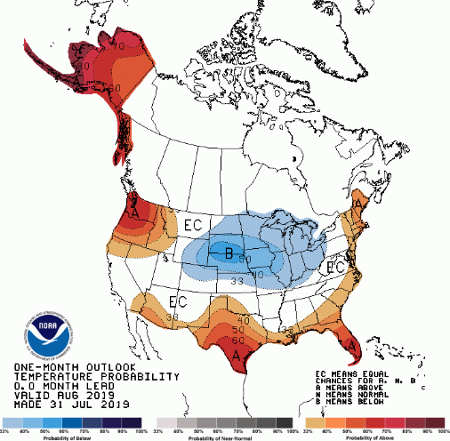By Laura Edwards
Latest Outlook
According to the latest climate outlook update, odds are favoring that August 2019 will be cooler than average. The update was released by NOAA’s Climate Prediction Center on July 31, 2019.

Figure 1. Temperature outlook for August 2019. Blue shaded areas have increased chances of being cooler than average. Red and orange areas have increased chances of warmer than average temperatures for the month overall.
Several computer models and forecasters have favored cooler than average conditions for August, and the models have been consistent with that message. South Dakota and Nebraska have the highest probability of anywhere in the country to be cooler than average for the month overall.
The picture of precipitation has changed slightly, since the last August climate outlook that was issued on July 18. Now, all but the northeast corner of the state is favored to be wetter than average for the month. The highest probabilities of wetter than average conditions are centered on southeastern Nebraska. This is where heavy precipitation is expected the first week of August and there is high confidence of total monthly rainfall to be higher than the monthly average.
For the first two weeks of August, the pattern is already shifting towards cooler and wetter in the North Central states. As of this writing, cooler and wetter than average conditions are favored across South Dakota through August 15.
Agricultural Impacts
The cooler and wetter pattern that is setting in place could be a mixed blessing for South Dakota farmers and ranchers. In a state where July rainfall was above average, two to three times average in many locations, more precipitation could cause further issues with wet soils and excess water already on the landscape. Without consistent warmth, there will be limited opportunity for soils to dry out as well.
Cooler than average temperature reduces the risk of plant stress, especially during the critical tasseling, flowering and grain fill period for corn and soybeans. However, with plant development much later than usual, cool temperatures also will not gain as many growing degree days as usual in August. This may further slow down crop development, especially in corn that is temperature-dependent for much of its life cycle. In July, temperatures were one to four degrees below average for most of the state, but some warm periods helped the corn crop progress to tasseling by month’s end.
The outlook for wet conditions could create concern for small grain harvest in the coming weeks. Additionally, it is time to consider cover crop seeding and winter wheat planting. Timing these field activities may be a challenge with wetter conditions in the field, and with limited time to dry out between rains.
While many pastures are greener and more productive than has been seen in many years, it is challenging to cut hay and have it properly cure or dry in the fields before baling. No matter how much rain falls through August, pasture and forage production is expected to be above to much above average for the season, according to the Grass-Cast tool.
For livestock, heat stress will likely not be a significant issue in August.
Source: sdsu.edu